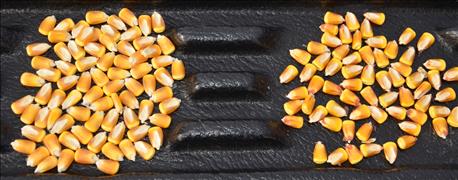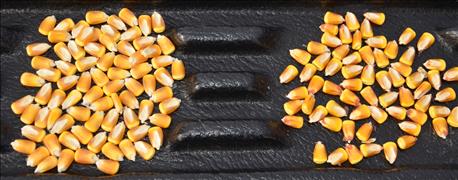
Look at the picture below carefully. Corn kernels shelled from Hybrid A are on the right side of the picture. Corn kernels from Hybrid B are on the left. What do you notice about these groups of kernels that set them apart?
Kevin Cavanaugh, Beck’s director of research, points out four things:
1. Size and shape of kernels. The kernels from Hybrid B on the left tend to be longer and slightly plumper than those of Hybrid A. If you could look at a cross-section of an ear from each hybrid, kernels from Hybrid B would be deeper and fuller.

GRAIN QUALITY MATTERS: If you’re making corn chips, you might be more particular about corn quality than if you’re feeding it to livestock. Hybrid B, on the left, is a food-grade hybrid, while Hybrid A, on the right, is not.
2. Test weight. While you can’t tell just by looking, and while both hybrids typically have test weights above 56 pounds per bushel, test weight for Hybrid B tends to be 1 pound or more per bushel higher than test weight for Hybrid A.
3. Color scheme. Look carefully at the kernels from Hybrid A on the right. There are reddish streaks running through some of them. There are no red streaks in the kernels from Hybrid B on the left. If you’re feeding livestock or selling corn to an ethanol plant, reddish tinge to kernels makes no difference, Cavanaugh says. But if you’re marketing corn to a company to make corn chips, it’s a big deal. Consumers don’t expect to see red streaks in their corn chips.
4. Starch quality. You can get some indication of starch quality by looking, and the hardness of the starch is easiest to tell by examining the kernels. Kernels from Hybrid B have a harder type of starch. That makes Hybrid B more desirable for a company wanting food-grade corn because the harder starch makes large grit size. It is more valuable than corn flour, which results from softer starch.
As it turns out, Hybrid B is on at least a couple of company lists in the food industry as acceptable for use as food-grade corn. Hybrid A is not. However, both hybrids have good quality. It all depends on the market for which you are producing the corn, Cavanaugh concludes.
About the Author(s)
You May Also Like




